It
is with great pleasure that we reproduce below “Marianne’s Story”. We are
very grateful for her permission to publish her recollections. What is so appealing to the serious researcher of the foundation garments of this era, is
the blunt statement that men tend to romanticize these garments. Beautiful they
might be on occasion, very effective too, however, they were never as
comfortable as modern foundations. For sure, a women who wears a corset for
genuine support may be very uncomfortable without it (as I know from
experience), however, such ladies would rather not need that support in the
first place. My husband says I am a ‘spoil-sport’ but Marianne brings us
down to earth.
I’ve
taken the liberty of editing the text, but as little as possible. Our own
comments are included in green italics.
Marianne’s
Story
Introduction
I
was born in 1939 and probably belong to the last generation of women who grew up
with classic foundation wear as a natural ingredient of life. To me they also
became an even more important part of life as I worked in the lingerie and
foundation-wear business from 1956 until 1973.
It was in the late 50’s that I started working in my Aunt's corset shop and then trained as a
corsetiere (quite
possibly the heyday of that era)
Certainly
this era has been very much romanticised by men, and from a woman’s
point-of-view, the advent of tights and the abolition of corsets, belts,
girdles, corselettes and what-nots was a blessing and an important stepping
stone for the liberation of this half of mankind! Of course all these garments
were such a normal part of life when I grew up that we hardly questioned their
use. They were what girls and women wore, full stop, and (by
today’s standards) they were not
always very comfortable and easy to handle. Materials, such as taffeta, satin
and rubber, were stiff, heavy, hot and not very hygienic. The girdles also wore out
quite quickly. Colours were rare and limited to white, pink and black. You
should not forget either that, at least in the middle and upper classes, good
corsetry was also a question of decency! But, they had their charm and value
too. One might remember that fitness and body trim were not very common with
women in those days, except for the rather rough gymnastics in the 1930's and
during the war. Health care and nutrition were neglected during the war and
women’s bodies were heavier and less well treated in those days, so some help
with forming and holding was often welcomed. Also the fashions in those days
craved good shaping and building up from underneath..
Not
until the miraculous Latex yarns were developed did the garments become somewhat
more comfortable, and it was well into the late 50’s that some models became
somewhat lighter and even smart! The light elastic belt was a blessing to many
young ladies in those days, whereas the panty-girdle of the mid-60’s was to
most a torment until the lighter models turned up around 1967/68. By then the
era of corsetry was coming to an end with the rapid spread of tights and a more
youthful fashion. Remember, up to the mid-60’s a well dressed girl was a little
lady, even though the teen-age look had come around with Audrey Hepburn in the
50’s. What
we would wear was not only a personal choice. It was to a great extent decided
by our age, figure, fads of fashion, time of the day, friends, and, not least,
mothers and female relatives; so these garments were surrounded with feelings of
oppression too. (Marianne’s
comments here strike a common chord with both my husband and me. As teenagers,
we were smaller carbon-copies of our parents. Even to go out for lunch required
a girdle for myself, and a shirt and tie for my husband.)
Foundation
Etiquette
Let
me share some of the etiquette as I remember it from my teens and twenties.
Girls of age seven to 14 were expected to wear cotton underwear in white or
pink. No girdles, but often a rather stiff bodice, or, in the teens, a narrow to
medium width garter belt. Stockings were usually white or black, cotton or (in
winter) woolen (oh how they itched!) and definitely no bras. By age 14 or 15,
nylons or silks were allowed for more formal occasions and nylon panties could
be accepted. The first short, cotton bra (usually AA or A cups and sometimes
well padded) was bought, and was a sign of approaching womanhood, a source of
pride! Now the bodice was also dropped and garter belts or light open girdles
were the rule. White, pink or patterned materials were the norm; never black and
certainly not red! (They were the colours of ‘bad’ girls). Such colours
would only be allowed if they were required by the outer garment, which they
rarely were, as slips were universally worn.)
|
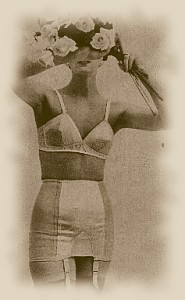
|
From age 17-18, the young body was
considered to be blossoming and in need of steady support and a longer, firm,
open girdle was recommended. The more formal the occasion, the firmer, more
boned and panelled it should be. Now cotton was usually swapped for nylon all
through, and the bras increased in size. Light blue, navy blue, yellow (if
available, it was hard to find before the 60’s) and even red was added to the
allowed colours around the age of 20-22. Black was still looked upon as nasty,
and so were, curiously enough, garter belts, except for simpler dance parties or
in the summertime. In daytime a rather short girdle was accepted if you did not
have much of a tummy to grapple with.
|
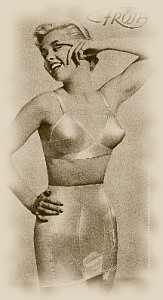
|
With
marriage came the liberty to wear any colour, including black (except for
panties, which should be white or pink. I remember a small scandal in my
home-town when a young newly-married neighbourhood wife exposed some five or so
little black nylon panties, with frills, on the laundry line in her
back-garden!).
More
mature married
women were expected to wear rather heavy ‘armour’ and, especially after childbirth, a short bra was very uncommon, except for summer dresses. Bras
should be long-line and preferably hooked to the long girdles waistband. The
combination looked like a corselette, but was more convenient since they could
be more easily fitted to most women.
Older
ladies born in the 1890 - 1920 period still wore the stiff corsets of the 30’s and 40’s, and it is funny to
remember how conservative and old-fashioned they seemed to us younger girls. Rigid fabric, front-lacing
corsets with inner panels, were also in demand from these ladies, and we did sell and fit quite a lot of
them. I also remember that they were
quite often handed in for repairs and little fixes, so obviously they were loved
and also very durable. I think one reason for this was, as I remember it, they
usually did not contain any elastic parts.
Mind you, some of us younger women were pretty slow in burning the bra and getting rid of the
girdles. I did not, for example, ever accept the panty-girdles, even though I
got a few of the early ones in the 50’s to wear under slacks. I
did wear girdles and stockings occasionally in the mid-70's, but by then it was
usually with evening dresses that required some shaping. Today I would never
even consider the idea of squeezing myself into a girdle and I was fascinated by
Madonna’s play with the ‘Vogue’ type girdles.
Working
in a corset and lingerie shop in this period, I know of course that all little
wives in their late twenties and early thirties did not stick to these rather
harsh rules. They got themselves more frivolous things from time to time. At
times garments bought abroad were brought in for refitting and filled us with
amazement and envy! This was especially true when our married sisters
returned from a charter trip by bus to Paris! One brand that we never carried
(probably for moral reasons) was Scandale, and many little things that were
handed over for alteration wore that label. In the shop we used to refer to them
as ‘titbits’ and had rather mixed feelings towards their owners. The owner
of the shop called them plainly ‘whorish things’ and left the younger
colleagues to work on them.
Times
were changing however, and life became simpler, but perhaps a bit more dull. I
remember one young wife in the early 70’s who came in to buy two everyday
light weight short elastic girdles, which were by then on sale. She remarked, in
a whisper, that she maybe was still a bit old-fashioned in sticking to girdles
and stockings, but “it is so convenient, at least on Friday nights”. To
relieve younger male readers of their curiosity I might add that panties in
those days, as long as it was possible, were worn on top of garters and girdles.
(Much
has been discussed on this point.).
Perhaps
it is worth pointing out that what you see in advertisements from the time is
not really the true picture of what girls and women really looked like beneath
their clothes. Many wore very worn out garments, patched and refitted with bad
elastics and white that was more yellowish. In the advertisements, the ladies
rarely wore stockings and slips so that the garment could be seen. The models also
wore their panties underneath their girdles for the same reason. In real life,
foundations without panties were never
seen in my profession, and I did not even consider it myself, even though there were rumours
about certain girls. I think it would have
been judged very harshly and seen as indecent! However, I remember that a female gynaecologist in my home town used to recommend
it for
health reasons, especially in the warmer parts of the year, but I do not know if
many followed that piece of advice. She was, naturally, a stout opponent of panty-girdles, a point
where I quietly agreed with all my heart! Panty-girdles
were not very popular at all until somewhere around 1966 when they came over
from the US and became very popular with younger girls, just to disappear very
soon afterwards as tights came on the market. Most women before that had just
one of those, usually to wear under slacks and perhaps for sports and leisure. I
always found them rather uncomfortable and never really recommended them to my
clients.
Working
in the Corset Shop
Basically,
the job of a corsetiere is to fit girdles and other foundations to the
enormous variations in the female body, since a badly fitted girdle will always
make problems worse.
|
As a beginner, I mainly worked at the stockings desk, but was
required, just like my aunt and the other shop girl, to be well dressed. This
also meant wearing good foundations from the shop's range of brands. I always
wore white, since black was considered rather risqué,
especially for a young girl in those days. It was a very expensive and rather
select garment and I remember feeling proud and rather grown-up when I wore it.
It was medium strength and not too uncomfortable, nevertheless, as long as girdles were rigid and boned, I used to slip
out of them as soon as I got home, but with the softer and shorter girdles that
arrived with the late 50’s, I often kept them on at home and only took my
stockings off! I can still almost feel that funny sensation when the garters
were dangling free under skirt and slip!
Since I lived in a small countryside town, the
attitudes were very conservative in its ways of life
and outlooks generally. I think that the styles were different in Copenhagen,
perhaps more advanced and modern, and that, for instance, the combination of a
girdle and a short bra was more widespread there than in my town (right).
|
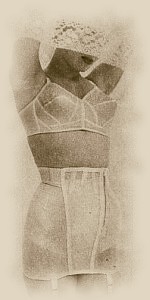
|
Stockings
may appear smart to many a nostalgic man, but were mourned by few girls and
ladies. The first nylons, which in my country appeared around 1948, were
extremely expensive and very, very fragile. There was a need of small shops for
stitching runs, which appeared at the most inconvenient moments. The period with
seamed stockings was a horror (check and double check!) and the arrival of
seamless stockings and even elastic ones was greeted with great joy by most. It
is true though that the first tights were not of best quality, but still they
were liberating. Of course the years around 1967/68 when they began to be sold
at large to most of us was not the time for the first contact with these. As
small girls we had had ‘stocking trousers’ in wintertime.
I
really never liked the corselettes, or all-in-ones, myself. The reason was that
they were very difficult to fit. (This
is graphically described in Alison’s Story. It's always amazed my husband that
a fundamentally simple garment like a corselette can arouse such passionate
debate in women.)
If they were bought in department stores, only the average woman could get a
good fit. It is also true that they were very hard to get into, toileting was a
problem (certainly
in the panty- version), and it often
felt like wearing a very stiff and hot bathing suit under your clothes. (Like
Alison, Marianne goes on at some length about the corselette.)
They were just as difficult to get out of as they were difficult to get into.
And as for the panty-corselette (a corselette with legs), I never even heard of
one in those days, and I still find it an unbelievable item. I really cannot see
any use for it at all. The combination of a high-rise girdle and a long-line
bra was so much more comfortable and easy to fit. There was also the freedom to
unhook your girdle from your bra on getting home, and still wear your bra.
|
Choosing a
corselette is a
delicate thing, as you have to be of quite 'normal' build. For
instance, if you had a bust size well above average, and hip and waist measures
below, you had a hard time finding a corselette that would fit well. In my active
days (late 1950's and 60's), I very rarely recommended this type of garment.
The combination of a girdle and a long-line bra hooked to the girdle was usually
a better solution, as you could find perfect sizing and make nice adjustments.
Miss Mary of Sweden
(www.missmary.se), however, made some
excellent corselettes. The factory used to be located in the textile town of
Borås, Sweden, where over 10 corset, girdle and bra factories
were active up until the 1970's. The company has been around at least since the
1960's and has a good reputation for everyday foundation wear. I think the
production has moved to Estonia or some other Baltic country, but as far as I know they have kept their good reputation.
(They
have indeed kept a good reputation, although, in common with most other
successfully marketed brands today, their main emphasis is on 'uppers' and
'bodies' rather
than 'lowers'.) |

|
I
do not think that a corselette was ever normally considered for a woman under
30, unless she had given birth several times. The softer roll-ons were a
blessing to girls in the age group 15 to 30, but in the 1950’s they were often
boned and zipped. A girl that was of slender build could wear a short bra
without any problem, and that was to become the normal outfit from the
mid-60’s.
As
to wide garters, I think they very much belonged to a time before mine. They
were around until the early 1950’s, but modern girdles were
fitted with much thinner garters. Throughout my time as an active corsetiere,
elderly ladies, of course, still demanded corsets or substantial girdles, and
these were usually fitted with wide garters.
Whether
to fit the garment with four or six garters was not much of an issue in Denmark.
Only for a short period did we see girdles fitted with six garters, and that I
think was under American influence. The rule was four garters, and that was tricky
enough. It took time to fasten and unfasten them, a task that needed to be
performed with precision in order to keep the seams straight. (This
is another male pre-occupation. Most women were delighted to banish the seams in
the mid-60’s.) On a girdle with a
rather long skirt, it seemed not so necessary to have six garters since the
stockings would not rotate anyway, if they were fitted close to
the rim of the girdle. With shorter skirts you would wear longer stockings and
shorten the garters and achieve the same end.
Men
have often asked me if the suspenders and stockings were the ‘worst part’
of wearing a girdle. Personally, I think it might be a problem to some, but far
from all. You got used to it quite quickly. Still, I think that
most women in those days would either get out of their stockings as soon as they
got home and were on their own. Quite a lot also removed their girdles whenever
they had the opportunity, so it was not always comfortable. The cinema
stereotype of "Let me just slip into something more comfortable" did
not grow out of nothing! Most women used to be bit ashamed of their foundations,
especially tight and heavy corsetry, even in front of their husbands, and
usually wanted to get out of them if they felt ‘intimacies’ were approaching.
Trying to remember if
garter bumps
were a problem in those days, I cannot really find that I personally worried
about it, nor did our customers. When everybody wore them, they were not really
an issue. Materials were usually somewhat heavier in those days
and the wearing of a full or a half slip was the usual thing. Fashionable
dresses those days were often lined, so I think the bumps caused by the garters would very rarely
show. Today young girls seem to wear dresses and skirts that are much thinner,
almost never lined, and slips are gone. This is in a way a pity because they
tend to stick to the body and the nice fall is lost. And, in bright light, you can
see through the dresses. That's not something I like. Thinking hard, I do remember
however, that very tight wool dresses could make a problem, so that I became
aware of the 'see-through' effect. Then I would take care to place
something on my lap when sitting, such as a handbag or a newspaper.
The
non-elastic corsets and girdles, especially the longer ones, restricted the
wearer´s ability to take long steps. This could be fixed, to some degree at
least, by cutting a small triangle out of the mid front panel and substituting
it with a piece of elastic. Some models were already fashioned in this way, but
not all. Boning (and stiffened side panels in general) had to be carefully
watched so they did not go too low down over the hip as this would cause
considerable problems when sitting down (read
the Cautionary Tale of the Vain Lady).
So, some of the trying on and fitting was made with the customer sitting in a
chair. Sitting and rising still could cause considerable problems if back
garters were too tightly fastened. They should always be somewhat looser than
front (and side) ones. Bending forwards could put too much strain on either the
garters or the stockings, with slipping of the garters, breaking loose of
garters, or even ruptures to the stockings as a result. If the girdle was not
fastened to the bra it could also, after kneeling or bending, slide down, so
that it had to be pulled up. Very awkward indeed!
|
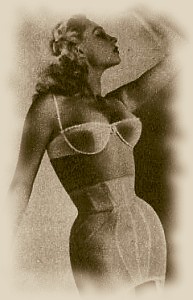
|
Bones,
particularly the very stiff kind, were used when strong non-stretch material
alone was no longer able to produce a flat tummy. Certainly, we had to move more
slowly and upright in these garments. Bones were essential to strapless bras of
course, and as I remember it, almost all bras, even shorter ones, had some
boning in the side panels or side elastics. I do remember poor young girls
accompanied by their conservative mothers or aunts. Often these elderly ladies
required makes and models that they were used to, and that at the time seemed
old fashioned to us girls. As an assistant in the corset shop I could not very
often influence these women to make a more modern choice, and I even remember
girls crying during fitting. As I became a fully trained corsetiere I always
tried to dissuade their parents from forcing the issue, since the young body
almost never needs boning. Partly this was because I experienced that myself as
a young girl, since the owner of the corset shop was my very conservative aunt.
She and my mother would decide on the most strict girdling already from my 15th
year. As an assistant I was also expected to be extremely well girdled in the
eyes of the customers. And you should know that in these days, women really did
have X-ray eyes for foundation wear!
|
Thinking
back on it, most mothers actually were quite
empathetic with their daughters when it came to foundations, as they knew themselves
what torments it might inflict if too rigid. If girls considered their mothers a
bit 'sadistic', it was usually due to the fact that they were
conservative in their choice, just like the older generation always is. So, the
question "Shouldn't you consider something more firm?", which was not
uncommon, usually came out of conservatism. The usual quarrels in the shop were over style and
type. This was particularly so in the
second half of the 1960's, when the industry settled for special lines for
teenagers and younger women. These were often seen as 'flimsy', or too
slack by many mothers.
The
better foundations are fitted, the less you notice them, but of course they were
always there. Still, stockings should almost never be felt as pulling. But the
more formally you dressed, the harder the garments would hold you, and some
ill-fitted garments would always make their presence felt! To me the long
panty-girdles were extremely difficult to fit, and as they appeared rather late
(at least in Denmark), the days of the corset shop were almost gone, and most
were purchased in department stores, so they would not be fitted at all. They
really could hurt you, and of course, were much of a nuisance when you went to
the bathroom. For these wretched garments, you had to have a very special
technique. It was so much easier with the short elastic girdle, which in Denmark
was usually was referred to as a ‘roll-on’. The panty-girdles were more of a
‘tug-on-and-grapple’. As the garters moved from below or outside on these
garments to inside the leg in the years 1958 - 1962, you had the added problem
of, after having tugged them on, sitting down on your bed-side, rolling up the
cuffs to get hold of the garters, fastening the stockings and then rolling and
tugging down the cuffs, which quite often would still ride up, so that a ring
of bare flesh between stocking top and girdle rim would appear after an hour or
so. The thigh would bulge out and a quick rush to the bathroom for another 'pull-down' was
your only chance! Rolling up the cuff created a strong band that would obstruct
your blood flow, so you had to be quick with it. No; they were horrible things
and we were amazed that they became so popular in the US. (We read quite a lot
of magazines in those days, and knew that habits differed quite a lot between
US, UK and the Continent.)
Adjusting
‘shape-wear’ (as the modern term goes) in public and at work was always a
nuisance and the focus of many jokes among men. You had to be discrete and
quick, but someone usually noticed. The worst thing that could happen was a
broken or loosened garter. A bit simpler was the loss of the garter button. It
could always be replaced by a one oere coin!
The Triumph girdle (it was not a corset
really) was not an actual rubber girdle, but you must understand, that before
Lycra arrived, the elastics were usually made up of rubber. The Playtex rubber
girdles were around for a while (the one that was sold in a tube). As they could not be fitted
and were mainly sold in department stores, they were not an interesting article
in a specialised lingerie and foundation store like my aunt´s. We did hold a
few in stock and they sold out slowly, mainly I think out of curiosity as
they were not widely marketed in Denmark. I got one for myself and tried it on
and did not particularly like it as it was rather uncomfortable and also carried
a faint, rather unpleasant smell of rubber. My aunt expected me to
try out 'novelties', especially if they were intended for a younger
audience, so that is one reason why I have rather good knowledge of all the new
things that appeared in the late 50's and early 60's. Some of them really
were dead ends and I think the rubber girdles actually were.
I
think the most tormenting effect of the garments of that era was the feeling of
being locked in, of being too heavily dressed and of being hot and sweaty.
Despite that, many professions, not least my own, required sensible foundations
as part of the 'uniform'.
|
I remember the two air stewardesses who worked for Scandinavian
Airlines (SAS). They both were regular customers and preferred
rather high rise and firm girdles (I wonder how they managed through long flights,
poor girls!). One of them was very fond of a type called 'Splendide' manufactured by a Swedish
company called Svegmarks. It was similar to the model on the right from
around 1956. This style was around for many years, late 40's until the mid-60's. Of course the materials varied, but the basic design
remained the same. I remember that she liked the high waist for never rolling and
the short skirt that did not inhibit her walking. In my eyes this was more of a
corset than a girdle and I was amazed that such a young woman (27) did not
choose something more modern. My aunt said it may have been company regulations,
but I doubt that.
Nurses in those days would buy what they called
'nurses stockings'. They
were support stockings of a type that was required by head nurses and the
matron. They were not very attractive, but actually were a boon to women who
spent all day on their feet.!
|
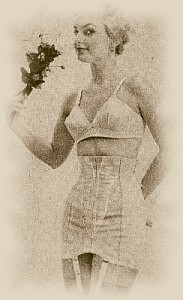
|
Corsetiere and
Attitudes
It is quite strange when talking to younger women and mentioning my occupation
as a corsetiere. Many haven’t even heard of the word, and even less have the slightest
idea about how women actually had to dress in those days. To them it may sounds
like something out of the middle ages. If
I ask them if they ever wear a garter belt, most of them have tried out of
curiosity in their teens, but if they still use them it is usually only on
special occasions, and very often on their boyfriends’ request. That may be OK
for fun, but a woman or girl should never wear anything that she does not really
like herself, I believe! The
closest you would ever get today, is more elderly women wearing soft
panty-girdles, because they need some tummy or bottom trimming. (There
are still some well-corsetted matrons in Britain, and I suspect many other
countries, but they are a minute percentage of the market - Il)
Regard the following comment “Like most women of my age, I have no intention
of going to a corsetiere to be ‘properly fitted’ with a girdle. The places
where I buy girdles don't offer that service. It's simply too off-putting for
words to let another woman scrutinise my figure and try to sell me a heavy-duty
girdle that I neither need nor want." I feel that this summarises the modern attitude of women towards foundations.
I went to a 60-year celebration last
Saturday here in Denmark and overheard a piece of conversation in the Ladies
Room that I would like to share with all of you. Dress code was dinner-jacket,
and, as is the habit here for birthdays, the ladies were all in their most
smashing evening gowns. On 'powdering my nose' I heard two ladies in
their later 50's as one of them came out of the cabinet.
"It took you some time in there. Everything all right?"
"(Giggles) Oh, yes, it was just this body that I bought for this occasion.
I couldn't unhook it down there with these nails, so I had to take the whole dress
off and pull the thing down. Quite acrobatic!"
"You have got a what!?"
"A body, one of these modern shapers, you know."
"Not a horrible Spirella? I remember when I had to help Mum hook up her terrible
thing. You don´t say you are wearing one of these?"
"No, it's modern one. A soft thing. Look!" (She lifted her gown to her
breasts).
"Oh, that looks different! I know what you mean. Is it any good?"
"Oh yes, it keeps the bulges in and it really is good for your figure. I would
never have got into this dress without it, but it is really a bit too soft. I
think I will look for something stronger in future."
"But, Heavens, you don´t wear that
everyday do you?"
"No, are you mad. I only wear it when I need it."
"But do they come without garters as well? I would never think of wearing
stockings again."
"Oh, this one does not have garters really. I had to put on a belt below to
hold up stockings. I do prefer tights too, but I could not get a thin pair with
seems in the hurry I was in, so that´s why I had to do it this silly way. But I
think there are some with detachable garters."
"Oh, you would not buy them with garters, would you?"
"Well, it isn't so bad. Feels rather nice and I had forgotten what it was
like. I could you know."
"Where did you get it?"
"(Mentions a shop)"
"Is that where you are going to get the stronger one?"
"Mm, I think so."
"Do you mind if I come along?"
"Not at all!"
Male
Attitudes to Girdles
Our
rural Danish town was quite idyllic and probably naive by today’s standards,
but of course, there was some whispering around. In general we heard that men
disliked corsetry intensely when it was worn by girl friends and wives. Still,
there were a few of our customers who would make remarks about what their
husbands did like, or about them requiring their wives to wear certain garments.
(In those days, most married women obeyed their husbands, I am sorry to say). We
also knew, either from our own experience or from customers stories, that
garments were stolen from laundry lines and drying rooms in apartment buildings,
and we did not believe that this was done by women. Rather we suspected
school-boys, but never knew for certain, except for a few cases when the thieves
were caught in action.
I
remember one scandal from the early 60’s vividly. It became known among most
of my friends, even though it was officially hushed up. In an apartment house
there had been extensive disappearances of panties, slips, girdles, bras and
stockings from the laundry drying room for over a year. It was then found out
that a little gang of four or five boys around 13 - 15 had been stealing, and
then wearing the items! I think you could imagine the gossip around this in our
little town! I do not think that it reached the ears of fathers and husbands
though.
Personally,
I find it strange that men would want to wear female under-garments, but I am
not at my age in any way condemning or moralistic about it. That many men also
take a nostalgic interest in what girls and women used to wear in their youth seems also quite obvious and may, I think, be explained by rather simple
psychology!
My experience from the period 1955 -
1970 in a small Danish town is that we never had a
man came to my aunt's shop to buy for himself (or
certainly to admit it). It did occur that men would drop
in and buy something for their fiancees or wives, but the most common item was a
pair of stockings. In those days they were considered quite appropriate gifts. To
give other intimate articles of clothing would have been most inappropriate in
those days.
Conclusion
Those
days are gone and very few women, if any, miss them. In those day a women’s
position in society was so different from today. So many more were not doing any
work outside their homes (as a matter of fact, millions had to leave working
life after the war) and the general attitude was very much more submissive.
But, times were changing and we have to accept that. The general life style has
changed enormously and so has fashion. Very few dress designs today require any
type of girdling.
Not
that I recollect that any corsetiere that I remember looked upon herself as
anything other than a trained women who was there to assist other women.
Salespersons, yes, but not of ill will. And certainly we tried to fulfill the
needs and wishes of our customers as they expressed them. Added to this was our
knowledge of the garments and the way to fit them. But, we could not really
critisise the spirit of the times, which was oppressive towards women; no more
than the gold fish in the bowl can analyse its water!
I was professionally part of that
period, I think the most 'revolutionary' development for over 100
years (perhaps excepting parts of the 1920's) in foundation garments took place in these
years, such as the availability of good elastic materials (e.g. Lycra), the new
beautiful designs and colours, and mass production of good girdles and
bras.
Our
trade declined with the decline of the girdle in the late 60’s and early
70’s and will not return. Having been in the trade, however, I find it nice
that some aficionados try to keep the memory and knowledge alive, but there is
no reason to become sentimental about this, and no reason to think that younger
women would ever, to any great extent, turn back to girdling and corseting.
Sometimes, however, I do think that it would be so much better if there were
more saleswomen in the general stores' lingerie departments having a better
knowledge of women's underwear.







